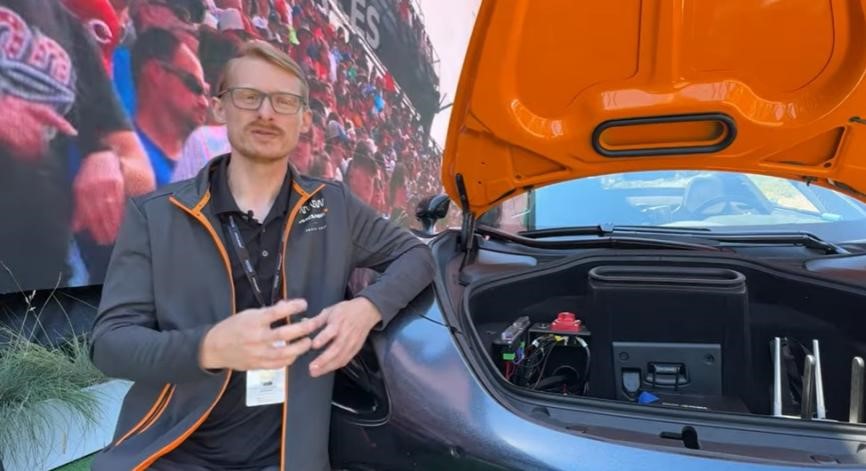Driven by artificial intelligence (AI) technology, the convergence of humans and machines has reached unprecedented heights. The combination of Nvidia's edge AI technology and Arrow Electronics' innovative program, SAM (Semi-Autonomous Motorcar), not only demonstrates the power of technology, but also profoundly changes the human life experience. This article will delve into this technological breakthrough and its impact on the development of semi-autonomous vehicles.
1.Technological breakthroughs: the application of edge AI in the automotive field
1. Edge AI technology
The Nvidia Jetson AGX Orin module is at the heart of this breakthrough. With its high-performance AI inference capabilities, this module makes it possible to process large amounts of data in real time. In the SAM project, it worked in tandem with a stereo vision camera to achieve the innovation of controlling the car's steering only with head movements through a customized head-tracking model.
According to Nvidia, the Jetson AGX Orin module has a processing power of up to 352 TOPS (trillion operations per second), which provides powerful support for real-time AI inference. This powerful computing power enables the SAM project to respond to the driver's head movements in milliseconds, greatly improving the system's response speed and driving experience.
2. Customize the head tracking model
Engineers at Arrow Electronics have developed a head-tracking model that is able to recognize and respond to the driver's head movements with extremely low latency. The implementation of this technology not only improves the response speed of the system, but also greatly enhances the user experience. By using a stereo vision camera, the system is able to accurately capture the driver's head position and angle, enabling precise steering control.
2. SAM project: Semi-autonomous vehicles that give new life
1. Project Background
The SAM project was developed by Arrow Electronics to help quadriplegic drivers regain control of the steering wheel. This project not only reflects the temperature of technology, but also a deep exploration of human potential. Former IndyCar racer Sam Schmidt, who was paralyzed from shoulder down in a car accident in 2000, was able to get back in the driver's seat through the SAM project and experience the thrill of driving at 200 mph.
2. Technical Implementation
Using an Nvidia Jetson AGX Orin module and a stereo vision camera, the SAM project successfully retrofitted the steering system of the McLaren 720S Spyder to respond to Sam Schmidt's head movements. In addition, through a special mechanism, Sam is able to control the acceleration and braking of the car by inhaling. This innovative control method not only provides the possibility of driving for people with disabilities, but also opens up a new path for the development of automotive control technology.
3. In-depth interview: Arrow's perspective
1. Project Details
During last month's Firestone Grand Prix event in Monterey, California, Arrow engineers Josh Willis and Stephen Harper explained the latest progress and technical details of the SAM project in an interview. Willis explained that the fourth-generation steering system no longer requires any headset to track the steering, but instead tracks the head movement directly through a pair of cameras, and all data processing is done by Nvidia modules.

Pictured: Arrow engineer Josh Willis explains the latest progress and technical details of the SAM project in an interview
2. Technical challenges and trade-offs
Stephen Harper walks us through the challenges they faced during development, including how to adapt custom models to find the best balance between accuracy and latency. He talked about how they built their own custom dataset for helmets related to head angle detection. The construction of this dataset enables the system to more accurately recognize and respond to the driver's head movements, thereby improving the accuracy and reliability of control.
4. Future Prospects: The next step for the SAM project
1. Technological development
As technology continues to advance, the SAM project is expected to further expand its capabilities. Haper mentioned that future SAM cars may explore new areas such as voice activation to give drivers more control. The expansion of this technology will not only further enhance the driving experience, but also provide more autonomy and convenience for people with disabilities.
2. Social impact
The SAM project is not only a technical achievement, but also a significant contribution to the improvement of the quality of life of people with disabilities. With the proliferation of similar technologies, we look forward to seeing a more inclusive and accessible society. Through the power of technology, more people will be able to experience the joy of driving and make their dreams come true.
Conclusion
Nvidia's edge AI technology and Arrow Electronics' SAM project demonstrate the infinite possibilities of AI to improve people's lives. By combining real-world data, technical details, and people's perspectives, this article aims to provide readers with a comprehensive and in-depth perspective on the importance and impact of this technological breakthrough. With the continuous development of technology, we have reason to believe that more innovations will emerge in the future, bringing more convenient and rich life experience to human beings.






